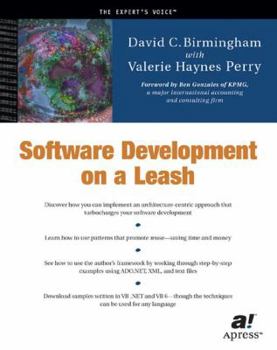Software Development on a Leash
Every developer wants to accelerate, reuse, and carry large portions of prior work into their next projects - this book shows developers how The author has 16+ years experience in commercial and military software architecture. He takes an innovative approach that aligns with how developers think and how technology is controlled and deployed. The main emphasis is on how to build programmable programs that dynamically adapt to changing user/application needs.
Format:Paperback
Language:English
ISBN:1893115917
ISBN13:9781893115910
Release Date:March 2002
Publisher:Apress
Length:456 Pages
Weight:1.93 lbs.
Dimensions:1.1" x 7.1" x 9.8"
Customer Reviews
5 ratings
whata-morphic?
Published by Thriftbooks.com User , 23 years ago
The author proposes a great approach and his passion about it jumps right off the pages. It's great to see a software development veteran who is still this excited about the profession. It's secondary evidence (to me) that his approach has at least some of the motivational aspects he describes.After a brief internet search, the word "metamorphic" in software context appears mainly for application porting and migration (if I have a C application to port to Java, for example). What the author proposes is something different: In his world, there is no "application code" in the program (it's *all* metadata).The author says that polymorphism is actually our enemy when attempting high-reuse, because application-specific relationships become entangled in the implementation. We can spin-off but we can't really take whole subsystems "as is" to completely new problem domains. The metamorphic approach, as I understand it, transcends this issue because no application code resides in compiled software.The download examples are eye-poppers. I have to say that I just gasped when I realized that he was dynamically reproducing screens directly from metadata created by the Microsoft IDE. As quickly as I changed a screen, the change was available without rebuilding the program. This could likely work for pulling in the definitions from any environment with screen-building functionality (PowerBuilder? Visio EA? Borland?) He ties in detailed behavioral control as well. After using Macromedia Flash and similar technologies, these also have a means to include a sort of behavioral "script" to guide the activities. The author describes similar behavioral macros to affect application activity, but for general computing. To troubleshoot, we only need a simple text editor rather than a full-blown development environment, and we can load/reload these textual instruction sets while the program is running. Would I find value in refreshing a user's desktop experience just by transmitting a new textual instruction set? Hmmm. Don't have to think too long about that one.Extrapolating, I suppose I could have a Unix and Windows version of a metamorphic program and run the same application metadata transparently on both. (Perhaps across both?). I don't see any difference in running a Unix/Motif based version of this while using Microsoft IDE metadata as screen-rendering instructions, or vice-versa (although the Gates/McNealy diehards will recoil in horror at this) The author supplies Visual Basic code for the book's examples. I'd like to see this in something more portable like C++. I'm tired of fighting the empty promises of Java.
Rating - 5 is not high enough!
Published by Thriftbooks.com User , 23 years ago
Our teams have used parts of these concepts for years, but this is the first time I've seen them integrated, and in way that makes sense. The author puts real flesh on the bones - and gives credibility (at last) to true reusability for application software. Why hasn't someone thought of this sooner?
Finally!
Published by Thriftbooks.com User , 23 years ago
All this time I thought "high reuse" was just a myth, and that I was doomed to spend my days at a keyboard. Birmingham hits it completely out of the park! I'm looking forward to applying these concepts and having some fun again.
Almost magical?
Published by Thriftbooks.com User , 23 years ago
When I first read the book's description, I was very skeptical of the contents. After reading the sample chapter (available from the Apress web site) I saw where Birmingham was going with it. The conclusion: this work is very impressive, well written and took me through some very practical and (like it says) innovative stuff that's just plain cool!
Home Run!
Published by Thriftbooks.com User , 23 years ago
I could not put this book down. Birmingham explains software development in a way that makes more sense than anything else I've ever read. Rather than get lost in the technical details, he actually explains and applies technology and reusability in a way I can actually use. A very profound work, and I'm ordering a dozen more copies for my development staff.





